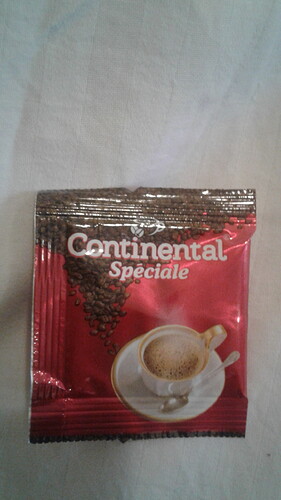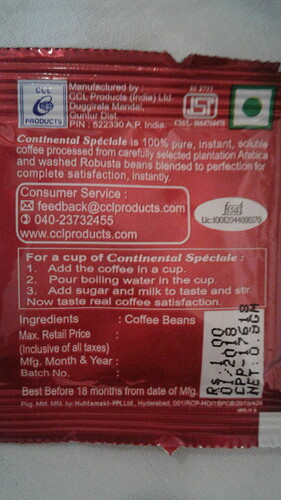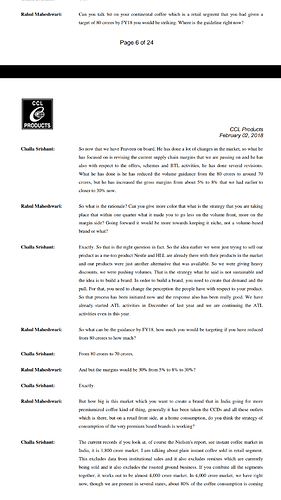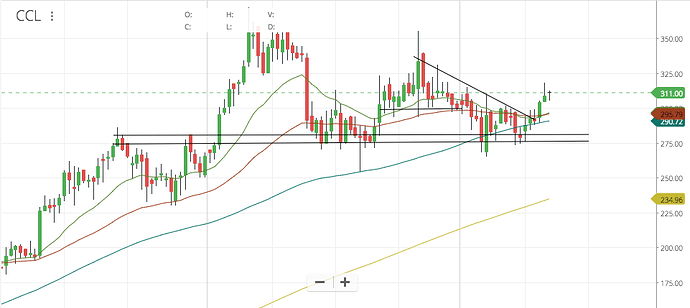Does anyone know what are the measures taken to prevent this type of fungus which occurred in 2014?
I think they are exporting 10,000 MT of green coffee. I don’t think this number is for processed soluble coffee.
Regards,
Rupesh
Thanks @mpbhat for excellent notes & several resources to understand industry and story. Thanks @Donald for explaining the investment thesis. I also have been doing some work, following are some notes.
COMPETITION
I have been trying to build competitive landscape to understand the story. Although more work is required, I found information on Olam to be quite useful.
OLAM
- Olam is a Singapore based independent coffee processing company run by Indian origin management.
- Olam reported capacity of 22000 MT in 2013 (4000 MT in 2008). Out of this, 12000 MT capacity is based in Vietnam (Spray Dried - 8000MT, Freeze Dried - 4000 MT). The additional 10,000 MT capacity is based in Spain (Spray Dried - 4500 MT, Freeze Dried - 5500 MT). The company plans to increase Vietnam capacity to 17250 MT by 2018.
- The company is operating at 100% capacity utilization as per latest presentation.
- The company has moved upstream into coffee estates unlike CCL.
Mota Mota, it looks like Olam is similar sized player as CCL & both are growing at the expense of some other players.
The global market size numbers provided by Olam are a little different than that of CCL (but it does not matter that much).
- The global soluble coffee market was 7.6L MT in size in 2014.
- Out of this, 70% is served by majore brand owners (like Nestle, JDE etc.) & rest (2,28,000 MT) is served by independent suppliers like Olam/CCL .
Olam had also had interesting section on yield →
- 2.5 MT of green beans are required to produce 1 MT of soluble coffee. This ratio is called as yield.
- A 1% improvement in the yield results in savings of US 45$/MT.
- Yield can be improved by maximizing extraction of soluble solids which can be achieved by adjusting time/temprature/particle size etc.
COLCAFE
- Colcafe is part of Colombian conglomerate Grupo Nutresa
- It has brands such as - Cafe Sello Rojo, Colcafe, La Bastilla, Matiz, Cafe Lalitud
- The company has 54% market share in ground coffee & 42% market share in soluble coffee in Colombia.
CCL’s effort to establish brand + retail operations in domestic market seems to be influenced by players like Colcafe, Klassik who clearly have significant market share in their home countries.
NUMBERS
While looking at numbers of CCL products in screener, I noticed 2-3 interesting things →
- Between 2006-2017, barring 2008, the company has shown growth in operating profit (moderate in some years) every single year. This is absolutely fantastic & this probably once again validates that company can pass through RM costs with good efficiency.
- There is high jump in operating profit in the years after fixed assets + CWIP has gone up. Considering #1 & #2 together leads to conclusion that - every time there is capex, growth will show up with very high probability (immune to commodity cycle).
e.g. Operating profit grew from 65Cr in March’11 to 87Cr in March’12. Fixes assets went up from 217Cr to 273Cr in the same period. Similar story in Mar’15 to Mar’16.
The additional 5000 T of freeze dried capacity (that comes online in Q1-2 FY19) shall prove to be similar if we are to go by past record.
- Assuming CCL charges fixed $$ for processing, whenever green coffee prices go up, RM cost as % of Sales shall go up & go down when prices drop. But gross/operating profit per MT shall more or remain same or get better.
e.g. Between March’09-10-11, topline went down, RM costs went down but operating profit went up. So any gyrations in topline & even margins shall be taken in this context. Absolute profit numbers (gross/operating/PAT) probably make more sense than % profit margins.
TODO
- I am still looking for reports on any smaller players (capacity < 5000 T) & how they have performed over last 4-5 years. That will validate the competitive advantage that players like CCL (and maybe Olam) have. If anyone has information, please do kindly share.
Disc - I have bought shares in last 90 days. < 5% of portfolio overall. This is not a buy/sell recommendation and investors are advised to do their own due diligence.
Roasting of Coffee linked to Cancer causing chemical in coffee and fries
Important line: The bottom line, for now, is that coffee retailers in California will have to post warnings. But that doesn’t mean there’s evidence that coffee itself is risky.
We need to try to understand if this applies to instant coffee made by CCL. Worth checking with management on quarterly earnings call. Above mentioned risk is for ground coffee. USA is not that big market for instant coffee.
Disc: invested
This apply not only to coffee but too potatoes fries . i read on WHO and Australian health websites as well. So no fries and coffee for me from now but i dont think it will have big impact . Coffee is like cigarette deep rooted in daily routines/addiction and there is huge lobby from Starbucks etc . interesting to see would be how market takes this news. CCL is on options market so not sure will it have any impact.
And exactly like this people stopped having fat in their daily food 30 years ago only to be told that the research were not done / not adequate / poorly executed and today all dieticians tell you that you must take some fat in your food.
One would need a far more rigorous and empirical evidence to start putting cause and effect in situations likes this. And even than, a 100% increase from 0.01% only take you to 0.02% . You may still have chance of dying on Delhi roads that are 100 times more !

I found this sachet of coffee at a hotel in Maharashtra. On tasting it I thoroughly enjoyed it. On further examination it emerged that it was manufactured by CCL products.
And, it seems this coffee is quite popular because I’ve seen it at other places as well. Though I wasn’t aware then that it’s manufactured by CCL.
I am regularly buying Continental strong from amazon 1kg@Rs650. This time I got a brochure along with it which mentions of its availability through Amazon,flipkart,ebay,shopclues,paytm,infibeam and bigbasket. I am unable to upload the PDF file due to some reason
CCL product is expanding very fast in chennai. some of the shops near to home in chennai are selling continental coffee with buy 1 get 1 offer. Even Dmart Pune is selling CCL with same offer.
It’s also available at Reliance Fresh outlets at Chennai since long with buy one get one offer, I have been buying regularly.
Even i also used to buy from reliance fresh earlier. But that was manufactured by CCL under its private label. But recently they started selling under their own brand “Continental” in many small shops around chennai.
I have been buying Continental from DMART in Pune which is having 1+1 offer currently.
Just trying to understand giving discounts and showing it as another me too product is not what they are targeting. They have changed the strategy in last quarter and planning to show it as a niche and has revised margin targets.
Whereas we are still getting it at a discount and started available in most of the shops? Is this part of brand building activity?
BTW, I also saw it being served in Secunderabad Pune Shatabdhi express.
Just wanted to know if anyone can tell the current capacity plant wise, product wise and future expansion in each plant. the concalls are very confusing.
- CCL has currently 20,000tn of capacity in India, with 15,000tn for spray dried coffee and 5,000tn for freeze dried coffee.
- Indian plant is currently running at peak utilization level of 98%.
- CCL’s Chittoor plant with 5,000tn freeze dried capacity is expected to get operational by 2HFY19. It comes under a SEZ and is expected to serve export markets. Expected to touch 50% capacity utilization level by FY19.
- With the above stated capacity expansion plan, capacity in India in FY19 is expected to go up to 25,000tn, of which 10,000tn will be for freeze dried coffee.
- Vietnam plant has 10,000tn capacity for instant coffee and 5,000tn for liquid coffee (which is convertible to 2,000tn of solid capacity). Utilization is unclear. Q3Fy18 conf call indicates almost peak utilization and one of the research report says 65%.
- Recent commissioning of agglomeration capacity in Vietnam plant could be bit misleading. Agglomeration is just a value added process of converting powder to granules. It is about creating another value added product within the same capacity.
- CCL has around 3,000tn plant in Switzerland (facing issues on account of unfavorable European Union regulations).
Triggers to track -
- Off take from upcoming facilities in India
- B2C sales via Continental brand
- Offtake in Vietnam facilities
Came across this news item
Does this hurt or help CCL products…Request inputs from boarders tarcking the company for long
CCL Q4Fy18 results are out…
Source: https://www.bseindia.com/xml-data/corpfiling/AttachLive/92952854-27e2-4fbc-adad-1d359c6c2070.pdf
Nice to see 226 cr capital-work-in-progress (5,000tn freeze dried plant), supported by 112 cr internal accruals and rest by debt. Growing balance sheet for high ROIC co. generally results in value creation.
CCL pays out ~25% of earnings as dividend. With >20% RoE (and even higher pre-tax RoE), would have preferred it to retain larger portion of earnings.
Does this business have significant entry barriers (or can CCL continue to earn high RoE)?
- This business has customer stickiness/loyalty. Because blends are CCL’s property. And CCL keeps the blend confidential. CCL has been selling ~1000 different blends in over 90 countries currently. These blends requires substantial R&D investment, thus not easily replicable.
- CCL has been in the market for a long period of time; have the right partners in each geography. Has taken almost 20 years to grow and reach current state. Steps initiated several years ago are paying off now.
- CCL has constantly been upgrading technology in-house, which enables innovative product offering ahead of competition. CCL commands trust and confidence of customers for innovation and timely deliveries.
(based on management commentary in Q3Fy18 conf call)
Q4 FY18 CONF CALL NOTES
DOMESTIC BUSINESS
- This included branded retail business, branded institutional business & private label business.
- In FY18, the business achieved sales of 46Cr - Retail (26Cr)
- The CEO of subsidiary has changed the model from 5-6% gross margin to 25-30% gross margin & a lot of cleanup happened in Q4. Targeting sales of 100Cr in FY19.
- In FY19, advertising & promotion expenses will be around 40Cr (20Cr more than FY18). 30Cr of these might be generated by subsidiary, parent might need to provide 10Cr. No support needed from parent starting FY20.
VIETNAM
- Profitability is sustainable in Vietnam, it largely depends upon product mix.
- Additional 2000-2500T of capacity can be added in Vietnam by line alignment (?) without any capex.
CAPACITY UTILIZATION
- The capacity utilization is 70-80% at Vietnam, we plan to increase it in FY19.
- The capacity utilization is optimal (100%) in India - excluding 5000T freeze dried capacity in SEZ.
- Guidance of 10-20% PAT growth in FY19, excluding 5000T new capacity. Topline growth might be lower due to lower green coffee prices.
SWITEZERLAND
- Switzerland contributed 77Cr to revenue, manufacturing contributed 20-30%. Mainly trading activity happens in Swiss subsidiary.
- The unit has broken even.
GREEN COFFEE
- Green coffee prices have gone up on full year basis in FY18 vs. FY17. That is why gross margins look down as we work on fixed cost/Kg basis.
- The green coffee prices have started going down in Q4 & might be lower in FY19 due to bumper crop in Brazil. Hence topline growth might not be same as PAT growth.
- Arabica beans have higher prices than Robusta beans because former has smoother taste & is more suited for coffee shops. Only when Arabica prices go up, demand for Robusta grows & prices go up.
MISC
- There is softness in freeze dried coffee market has two new plants have come online. A few companies have announced plans to increase capacity Due to this, customers are not aggressively placing orders compared to last year. If someone is aware of these players, do revert back on forum.
- One (or only?) soluble coffee manufacturer in US with 10,000T capacity is shutting down plants. This was 50 year plant where company figured out that it was not worth to re-invest. The outsourcing of this capacity has started & many players are competing to to get the piece of the pie.
- Export incentive of 37Cr for FY18.
- Nestle-Starbucks deal ->
https://www.nestle.com/media/pressreleases/allpressreleases/nestle-press-release-may-2018
http://edge.media-server.com/m/go/Nestle-2018-InfoCall
Disc - I continue to hold, < 5% of portfolio, no transactions in last 90 days, not a buy/sell reco
Coffee exports to take a hit of 10-15% this year due to dry weather in Karnataka.





